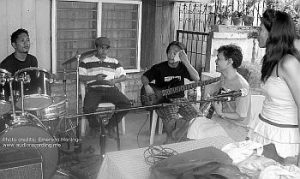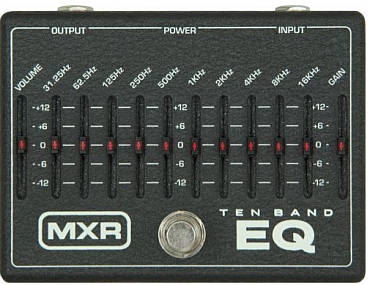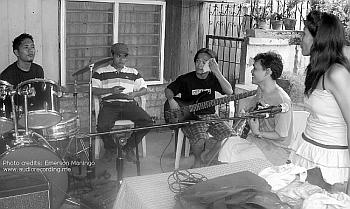This post will highlight all possible ways on how you can improve the sound quality and clarity of your band practice. Have you noticed that if you are doing band practice whether at your friends’ garage, the overall sound is lacking in clarity despite of the loudness? For example, you noticed that vocals get drowned overall as a result you can hardly hear the vocals despite all the screaming and maximizing the vocal volume. Also have you noticed that drums are so very loud that it can mask all the band instruments sound? Lastly have you observed that the deep bass guitar lines are not even clear and are masked because of loud guitars/drums?

Why the band rehearsal practices sound so muddy?
The root cause of this problem is that the audio frequencies of different musical instruments are not well mixed together. As a result, one instrument tends to dominate another in the same frequency range and the one with lower volume will be likely masked or deeply buried in the overall resulting mix. Unfortunately not all bands can afford an expensive audio mixer (which can solve this problem easily) and a sound engineer for every band practice.
Using the some important concepts in mixing audio, any band can improve the music and sound clarity of their live performance using only guitar amplifiers, bass amplifiers and EQ pedals at a minimum (these set of gears will always be present during any band practice). Check if your guitar, bass and vocal amplifiers have at least BASS, MIDDLE and TREBLE knobs on it. This is how it looks like on a guitar amplifier (using Ibanez TBX150H Guitar Amplifier):

Credits: Library Musicians
This tutorial will primary focus on EQ adjustments made directly on your guitar amplifier cabinet or guitar/bass EQ pedals which are also common, such as the MXR 10-band graphic equalizer.

These EQ pedals can also be implemented on live vocals.
Cut guitar and bass guitar middle frequencies to improve vocal clarity
The vocal is one of the most important parts of the band practice because the singer or the lead vocalist will always be the star during the concert. However these are often ignored in most band practice setups and instead focus more on other instruments. There are two basic instruments that can drown or masked the vocals during band practice:
a.) Guitars
b.) Bass guitars
Snare drums and other drum parts are an exception because in small band practice setup; there is no need to put microphones on drums since it is already loud.
Vocal frequency range is mostly found in the mid range (middle frequencies). Supposing a setting of 1 corresponds to maximum setting on any band of the guitar amplifier EQ knob and setting of 0 to be the minimum. Then to improve vocal clarity:
a.) Lower down the MIDDLE equalization setting of guitar and bass amplifiers to around 0.3-0.5(preferably less than half). This will cut the middle frequency elements of the guitar, creating a hole in the middle frequency range for the vocals to sit nicely in the mix.
b.) If you are using an EQ pedal for either bass or guitars, you can cut the following frequencies:
500Hz = -6dB
1 KHz = -6dB
2 KHz = -6dB
c.) If you have EQ control for the vocals, boost +3dB on 500Hz, 1000Hz and 2000Hz. This will drastically improve vocal clarity in the band practice.
Cut guitar and vocal bass frequencies for bass guitar to sit
The next problem is the bass clarity; you can cut implement the following EQ on Guitar amplifiers:
Guitar amplifier bass control knob: 0.3-0.5
Using EQ pedals:
31.25Hz = -6dB
62.5Hz = -6dB
125Hz = -6dB
If you have EQ control for vocals, cut -6dB on 125Hz, 62.5Hz and 31.25Hz. To improve guitar distortion heaviness clarity particularly for rock bands, boost +3dB using EQ pedal on 250Hz and 4 KHz. To further improve deep bass guitar clarity, boost +3dB on 31.25Hz, 62.5Hz using an EQ pedal. Or using bass guitar amplifier EQ knob, switch the bass control to 0.75 to max. Finally, let the band play a song. Use the volume settings on all amplifiers to finally balance the volume of all instruments. Since drums will be louder, it is advisable for the drummer to be in “dynamics” and “comparable in volume” with the rest of the musical instruments for the EQ settings to work its magic during band practice.
Content last updated on August 12, 2012









3 Responses
Hi Emerson,your article it’s awesome!
But what about if there are two guitars?and even a keyboard?how do you equalize in this case?
Thank you for your time
The key is to have a balance volume throughout. If you set the EQ pedal as suggested, you might encounter loss of volume of that specific instrument being adjusted if you cut more than you boost during EQ. So it make sense to compensate this lost volume with your amp knobs.
On the opposite if you boost more than you cut during the EQ settings, you are adding more gain thus resulting to more volume for that instrument. In this case, I would turn the amp knob down a bit to compensate the increase in volume.
Now here is the catch, some EQ pedal has some gain compensation control (such as illustrated in this tutorial). So you can adjust the gain compensation only on your EQ pedal and not on your amp (amp settings neutral).
On the other hand, you can as well hod the EQ pedal gain settings neutral and do the adjustment on the amp.
Either way could work and it depends on the feature of your amps or pedals.
Overall, you should pay attention to the resulting volume of the live band mix to make sure they are balanced and all instruments have its place in the mix.
Hi, so it’s either the EQ pedal settings, or the AMP control knobs? If for example I set the EQ pedal as explained, then the amp knobs would have to be at 0.5/neutral?